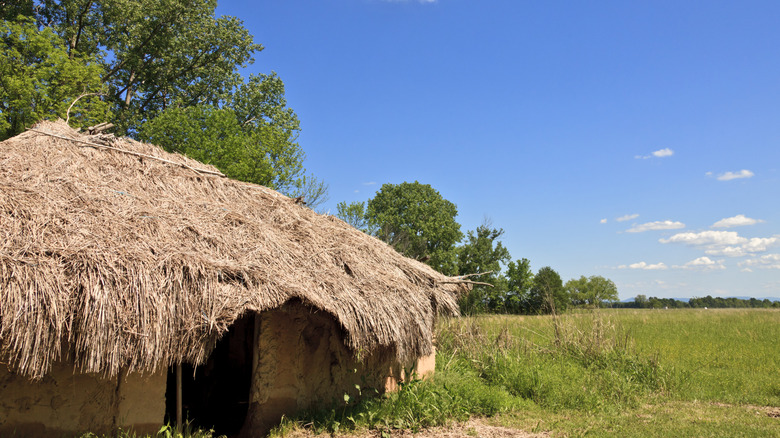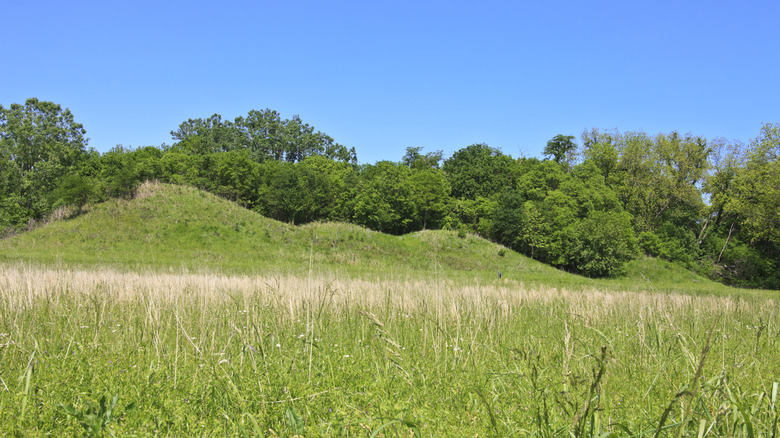One Of Oklahoma's Most Renowned Archaeological Sites Hides Just Outside A Small Town Near The Arkansas River
From 800 to 1450 C.E., a Native American community lived, worshipped, and traded on a wide stretch of land next to the Arkansas River. Today, the remains of this erstwhile community, in modern-day Oklahoma, are still visible. Spiro Mounds Archaeological Center, once home to the Indigenous Mississippians, is the state's only publicly accessible Native American site, located in Le Flore County just seven miles from the small town of Spiro, Oklahoma. Twelve mounds were discovered across 150 acres for the public to explore, including preserved artifacts inside the museum and traditional, re-constructed Native American houses on the site's grounds.
Archaeologists have unearthed mounds all over the world, but a distinct type has been found throughout the United States and Canada. These human-made, hill-like structures are believed to be the remnants of ceremonial sites, burial grounds, and domestic buildings. Due to its proximity to the Arkansas River, trade played a central role at Spiro Mounds, making this prehistoric village a thriving place for commercial exchange. As Dennis Peterson, archaeologist and director of Spiro Mounds Archaeological Center, told Chasing History, "The rivers are the highways in prehistoric America." But the Mississippian period wasn't only a time of commercial trade. The Caddoan speakers swapped political ideas, religious beliefs, iconography, and horticulture with tribes in other areas of the country, extending to present-day California and Mexico.
This fascinating insight into America's native history makes Spiro Mounds Archaeological Center a must-see on your next visit to Oklahoma. Comparable to the underrated Native Puebloan ruins in Colorado's Mesa Verde National Park and the towering red rock ruins of Wupatki National Monument in Arizona, exploring the architectural remains of America's ancient people is important for us contemporaries in gaining a deeper appreciation for Native American culture.
Spiro Mounds is one of the country's most important Native American archaeological sites
When the Spiro Mounds were found in 1935, the Kansas City Star compared them to the monumental discovery of Tutankhamun's tomb in 1922. After excavations in the '30s and '40s, Spiro Mounds Archaeological Center officially opened in 1978. Opening hours are 9:00 a.m. to 4:00 p.m. Tuesday to Saturday, and the entry fee is $4 for one adult and $1 for 6 to 18-year-olds. Spiro Mounds Archaeological Center also operates tours during solstices and equinoxes, similar to other ancient architectures around the world, like Ireland's neolithic Newgrange tomb which hosts gatherings during the winter solstices.
Tourists can explore Spiro's ancient land on a two-mile interpreted trail and a half-mile nature trail, however, trails are closed to the public outside the museum's business hour. On these routes, visitors can walk through the former farming land where Native American women worked 12 hours per day tending to the agriculture and feeding the village. Although the mounds themselves date back to 800 C.E., when the first community settled here, the land itself was the camping grounds for nomads over 8,000 years ago. This makes the site even more incredible as you imagine the quondam population whose footprints exist beneath your own. In the museum itself, you'll view artwork depicting ancient Americans as they saw themselves, copper, stone, and wooden tools, pottery, ceremonial objects, effigy pipes, fragments of a cotton shawl, other pieces of preserved fabric, and many more prehistoric artifacts.
So, what else can you do in the area? While the nearby town of Spiro is a quiet, mostly residential area, the Oklahoma-Arkansas border is only a short drive away, with the city of Fort Smith, 16 miles from Spiro Mounds, boasting plenty of restaurants, nightlife, and museums.

